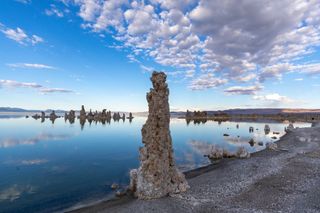A carbonate-rich lake solution to the phosphate problem of the origin of life
Jonathan D. Toner and View ORCID ProfileDavid C. Catling
PNAS January 14, 2020 117 (2) 883-888; first published December 30, 2019 https://doi.org/10.1073/pnas.1916109117
Edited by Jonathan I. Lunine, Cornell University, Ithaca, NY, and approved November 27, 2019 (received for review September 16, 2019)

Source/Fonte: (Image: © Matthew Dillon/Flickr/CC BY 2.0
Significance
Phosphate is crucial for the origin of life because it is ubiquitous in key biomolecules. A major issue is that prebiotic syntheses use concentrated phosphate to incorporate phosphate into biomolecules, whereas natural waters are generally phosphate-poor because phosphate reacts with calcium to form low-solubility apatite minerals. Here we show that carbonate-rich lakes can concentrate phosphate to >1 molal levels by locking up calcium in carbonate minerals, which prevents phosphate removal by apatite precipitation. Phosphate-rich lakes may have preferentially formed on the prebiotic Earth because of carbonic acid weathering under CO2-rich atmospheres and the absence of microbial phosphate consumption. This specifically points to an origin of life in carbonate-rich lakes, and so defines aqueous conditions that prebiotic chemists should consider.
Abstract
Phosphate is central to the origin of life because it is a key component of nucleotides in genetic molecules, phospholipid cell membranes, and energy transfer molecules such as adenosine triphosphate. To incorporate phosphate into biomolecules, prebiotic experiments commonly use molar phosphate concentrations to overcome phosphate’s poor reactivity with organics in water. However, phosphate is generally limited to micromolar levels in the environment because it precipitates with calcium as low-solubility apatite minerals. This disparity between laboratory conditions and environmental constraints is an enigma known as “the phosphate problem.” Here we show that carbonate-rich lakes are a marked exception to phosphate-poor natural waters. In principle, modern carbonate-rich lakes could accumulate up to ∼0.1 molal phosphate under steady-state conditions of evaporation and stream inflow because calcium is sequestered into carbonate minerals. This prevents the loss of dissolved phosphate to apatite precipitation. Even higher phosphate concentrations (>1 molal) can form during evaporation in the absence of inflows. On the prebiotic Earth, carbonate-rich lakes were likely abundant and phosphate-rich relative to the present day because of the lack of microbial phosphate sinks and enhanced chemical weathering of phosphate minerals under relatively CO2-rich atmospheres. Furthermore, the prevailing CO2 conditions would have buffered phosphate-rich brines to moderate pH (pH 6.5 to 9). The accumulation of phosphate and other prebiotic reagents at concentration and pH levels relevant to experimental prebiotic syntheses of key biomolecules is a compelling reason to consider carbonate-rich lakes as plausible settings for the origin of life.
FREE PDF GRATIS: PNAS Sup. Info.


